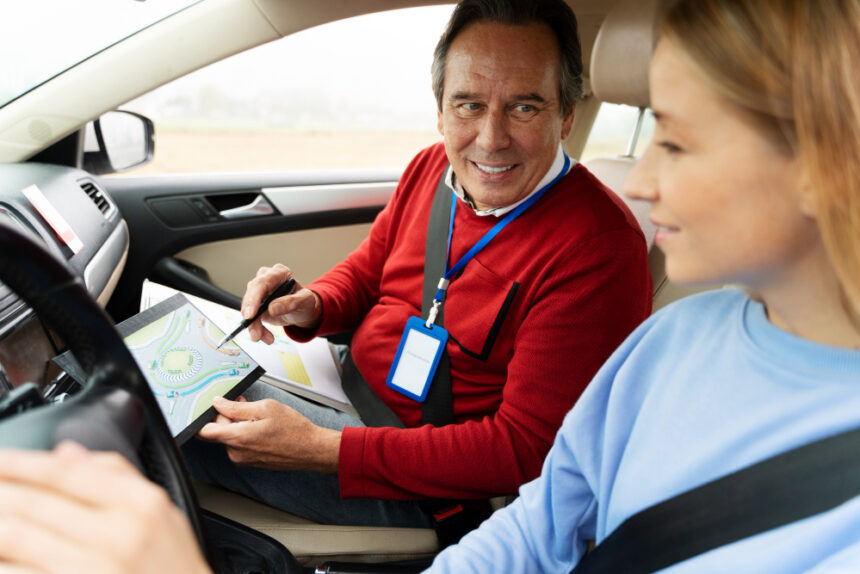Embarking on the journey to obtain your New York driving permit is more than just a step towards mobility; it’s a gateway to newfound freedom and responsibility. Whether you’re a fresh-faced learner or a seasoned traveler looking to refresh your knowledge, mastering the permit test is your passport to the open road.
In the bustling streets of the Empire State, understanding the rules of the game isn’t just advisable; it’s essential. This guide is your trusted companion, designed to demystify the test, equip you with invaluable insights, and pave the way for confident, safe, and informed driving. So, fasten your seatbelt, adjust your mirrors, and let’s navigate the path to success together. From road signs to the right of way, we’ve got it all covered. Let’s hit the road!
Related: Toeic Reading Test with Answers PDF
- Sample New York Driving Permit Test Questions and Answers PDF
- What is the Purpose of the Test?
- Who Needs to Take the Test?
- How to Prepare for the Test?
- Key Topics Covered in the Test
- Common Mistakes to Avoid
- Tips for Acing the Test
- Overview of the New York Driver's Manual
- Free Resources for Test Preparation
- Post-Test Procedures
- Final Thoughts
- FAQs
Sample New York Driving Permit Test Questions and Answers PDF
Question: What should you do when approaching a school bus with flashing red lights?
Answer: You must stop and remain stopped until the red lights stop flashing.
Question: When parking uphill with a curb, which way should you turn your wheels?
Answer: Turn your wheels away from the curb.
Question: What is the speed limit in a school zone?
Answer: The speed limit in a school zone is 20 mph.
Question: When should you use your headlights?
Answer: You should use your headlights from sunset to sunrise, and whenever visibility is less than 1000 feet.
Question: What should you do if you are involved in a collision?
Answer: You must stop and give your name, address, and insurance information to the other parties involved.
Question: What is the penalty for driving without insurance in New York?
Answer: The penalty for driving without insurance in New York includes fines, license suspension, and possible imprisonment.
Question: What should you do if you are approaching an intersection with a flashing red light?
Answer: Treat it as a stop sign. Come to a complete stop, then proceed when it is safe.
Question: What is the purpose of a regulatory sign?
Answer: Regulatory signs inform drivers of specific laws or regulations that must be obeyed.
Question: When is it permissible to pass a school bus with flashing red lights?
Answer: It is never permissible to pass a school bus with flashing red lights.
Question: What is the legal blood alcohol concentration (BAC) limit for drivers over 21 years old in New York?
Answer: The legal BAC limit for drivers over 21 years old in New York is 0.08%.
Question: What is the recommended following distance behind another vehicle on a highway?
Answer: A recommended following distance is at least 3-4 seconds behind the vehicle in front of you.
Question: What should you do if you encounter a steady red traffic light?
Answer: You must come to a complete stop and remain stopped until the light changes to green.
Question: When are you required to yield the right-of-way to pedestrians in a crosswalk?
Answer: You must yield the right-of-way to pedestrians in a crosswalk at all times.
Question: What is the penalty for passing a stopped school bus with its red lights flashing?
Answer: The penalty for passing a stopped school bus with its red lights flashing can include fines, points on your driving record, and potential license suspension.
Question: What is the purpose of an acceleration lane on a highway?
Answer: An acceleration lane allows you to increase your speed and merge safely with the flow of traffic.
Question: When is it legal to use a hand-held cell phone while driving in New York?
Answer: It is illegal to use a hand-held cell phone while driving in New York, except in emergency situations.
Question: What is the penalty for driving with a blood alcohol concentration (BAC) of 0.18% or higher?Answer: The penalty for driving with a BAC of 0.18% or higher may include higher fines, longer license suspension, and mandatory alcohol assessment.
Question: What should you do if your vehicle starts to skid on a slippery road?
Answer: Steer in the direction you want the front of the vehicle to go and avoid slamming on the brakes.
Question: When is it legal to pass another vehicle on the right?
Answer: It is legal to pass another vehicle on the right when there is an available lane for passing.
Question: What should you do if you are approaching a railroad crossing with flashing lights and ringing bells?
Answer: You must stop at least 15 feet from the nearest rail and wait until the lights stop flashing and the bells stop ringing.
Question: What is the purpose of a yield sign?
Answer: A yield sign indicates that you must slow down and yield the right-of-way to oncoming traffic or pedestrians.
Question: What is the maximum speed limit in New York City unless otherwise posted?
Answer: The maximum speed limit in New York City, unless otherwise posted, is 25 mph.
Question: When should you use your turn signal?Answer: You should use your turn signal at least 100 feet before making a turn or changing lanes.
Question: What is the penalty for driving without a valid driver’s license in New York?Answer: Driving without a valid driver’s license in New York may result in fines, potential license suspension, and possible imprisonment.
Question: When is it permissible to make a U-turn in New York City?
Answer: It is generally illegal to make a U-turn in New York City, except at intersections where a sign permits it.
Question: What should you do if you are involved in a minor collision without injuries?
Answer: Move your vehicle out of the traffic lane, if possible, and exchange information with the other driver(s) involved.
Question: When is it necessary to use your headlights?
Answer: You should use your headlights when visibility is less than 1,000 feet, such as during rain, snow, fog, or dusk.
Question: What is the purpose of a no-passing zone?
Answer: A no-passing zone indicates an area where passing is prohibited due to limited visibility, curves, or intersections.
Question: What is the penalty for driving with a learner’s permit without supervision in New York?Answer: Driving with a learner’s permit without supervision by a licensed adult may result in fines and potential suspension of your permit.
Question: When is it necessary to stop for a stopped school bus with its red lights flashing on a divided highway?
Answer: Even on a divided highway, you must stop for a stopped school bus with its red lights flashing if you are on the same side of the road as the bus.
These questions cover a wide range of important topics for safe and responsible driving in New York. Remember to study the New York Driver’s Manual thoroughly and practice these principles while on the road.
What is the Purpose of the Test?
The primary purpose of the New York driving permit test is to ensure that aspiring drivers have a comprehensive understanding of the rules and regulations that govern the roads. It aims to assess your knowledge of various aspects, including traffic signs, right-of-way rules, and appropriate responses in emergency situations. Passing this test demonstrates your readiness to be a responsible and safe driver.
Who Needs to Take the Test?
Anyone applying for their first-time driver’s permit in New York, regardless of age, is required to take this test. This includes teenagers as well as adult learners who are venturing into the world of driving for the first time. Additionally, if your learner’s permit has expired, you will need to retake the test.
How to Prepare for the Test?
Preparation is key to success. Start by obtaining a copy of the New York Driver’s Manual from a local DMV office or online. This comprehensive guide covers everything you need to know. Take the time to read and understand it thoroughly. To reinforce your knowledge, utilize practice tests available both online and in print. These simulate the actual exam and familiarize you with the format of questions.
Key Topics Covered in the Test
Now that you have a general understanding of the purpose and importance of the New York driving permit test, let’s delve into the specific topics that it covers. Familiarizing yourself with these key areas will significantly increase your chances of success.
Traffic Rules and Regulations
This section evaluates your knowledge of New York’s traffic laws. It includes questions about speed limits, right-of-way, signaling, and other fundamental rules that govern how drivers should behave on the road. Pay special attention to areas like stopping for school buses, yielding, and understanding the consequences of driving under the influence.
Road Signs and Signals
Recognizing and understanding road signs is critical for safe driving. The test will assess your ability to identify various signs, their meanings, and the appropriate actions to take in response to them. This includes regulatory signs, warning signs, and guide signs that provide directions to specific locations.
Defensive Driving Techniques
Being a defensive driver means being aware of your surroundings and anticipating potential hazards. Questions in this section may focus on techniques like maintaining a safe following distance, using mirrors effectively, and anticipating the actions of other drivers.
Handling Emergency Situations
Knowing how to react in emergency situations can be a lifesaver. This part of the test assesses your knowledge of actions to take in case of accidents, breakdowns, or encountering unexpected hazards on the road. It’s crucial to understand how to safely navigate these situations and protect yourself and others.
By understanding and thoroughly preparing for these key topics, you’ll be well-equipped to tackle the New York driving permit test and demonstrate your commitment to safe and responsible driving.
Common Mistakes to Avoid
While preparing for the New York driving permit test, it’s important to be aware of common pitfalls that could hinder your success. Steering clear of these mistakes will put you on the path to passing with flying colors.
Not Studying the Manual Thoroughly
Relying solely on practice tests without thoroughly reading the New York Driver’s Manual is a common error. The manual contains essential information that may not be covered in practice questions. Take the time to go through it carefully, making notes of important rules and regulations.
Neglecting Practice Tests
On the flip side, solely reading the manual without practicing is also a mistake. Practice tests serve as valuable tools to assess your knowledge and familiarize yourself with the format of questions. They also help identify areas where you may need additional study.
Underestimating the Significance of Road Signs
Some test-takers overlook the importance of road signs and signals, assuming they can rely on intuition. However, knowing the meanings and actions associated with each sign is crucial for safe and lawful driving. Allocate ample time to study and memorize these symbols.
By avoiding these common mistakes and following a comprehensive study plan, you’ll be well-prepared to pass the New York driving permit test and take the first step toward becoming a licensed driver.
Tips for Acing the Test
Now that you’re aware of the key topics and potential pitfalls, let’s explore some effective strategies to ensure success on the New York driving permit test.
Regular Practice and Revision
Consistency is key when it comes to preparing for the permit test. Set aside dedicated time each day to review the manual, take practice tests, and reinforce your understanding of traffic rules and road signs. This regular practice will help solidify your knowledge and boost your confidence.
Taking Online Practice Tests
In addition to the official practice tests provided by the DMV, consider utilizing online resources. There are numerous websites and apps that offer a wide range of practice questions. These resources often provide detailed explanations for correct answers, allowing you to learn from your mistakes.
Seeking Professional Guidance
If you find certain topics particularly challenging, don’t hesitate to seek guidance from a professional instructor or enroll in a driver’s education course. Experienced instructors can provide valuable insights and targeted instruction to help you master difficult concepts.
Overview of the New York Driver’s Manual
Understanding how to effectively utilize the New York Driver’s Manual is crucial for successful test preparation. Let’s take a closer look at this invaluable resource.
Where to Access the Manual
The New York Driver’s Manual is readily available both online and in print at local DMV offices. You can download a digital copy from the official DMV website or pick up a physical copy during your visit.
Key Sections to Focus On
While the entire manual is important, pay special attention to sections covering traffic laws, road signs, and safe driving practices. Familiarize yourself with the layout of the manual so you can quickly locate information when needed.
By incorporating these tips and effectively utilizing the New York Driver’s Manual, you’ll be well-prepared to tackle the permit test and take a significant step toward obtaining your driver’s license.
Free Resources for Test Preparation
In addition to the New York Driver’s Manual and practice tests, there are several other valuable resources available to aid in your preparation for the driving permit test.
Official DMV Website
The official New York DMV website is a treasure trove of information and resources. It offers a wide range of practice tests, study guides, and instructional videos. Take advantage of these resources to reinforce your knowledge and gain confidence before the test.
Mobile Apps and Online Forums
Numerous mobile apps are designed to help aspiring drivers prepare for their permit test. These apps often feature interactive quizzes, flashcards, and simulated practice exams. Additionally, online forums and communities provide a platform to ask.
Post-Test Procedures
Congratulations on completing the permit test! Now, let’s explore the steps you’ll need to take after the test to move forward in the process of obtaining your driver’s permit.
Receiving Your Permit
If you pass the permit test, you will be issued a learner’s permit. This permit allows you to practice driving under the supervision of a licensed adult. Be sure to carry your learner’s permit with you whenever you’re behind the wheel.
Additional Requirements for Young Drivers
For young drivers, there may be additional requirements beyond passing the permit test. These could include completing a certain number of supervised driving hours, enrolling in a driver’s education program, or meeting other eligibility criteria. It’s important to familiarize yourself with the specific requirements in your state.
Final Thoughts
Successfully passing the New York driving permit test is a significant milestone on your journey toward becoming a licensed driver. By dedicating time to studying the manual, taking practice tests, and utilizing various resources, you’ve demonstrated your commitment to safe and responsible driving.
Remember, this is just the beginning of your journey, and continued practice and education will be key as you progress toward obtaining your full driver’s license.
FAQs
How many questions are on the New York driving permit test?
The number of questions on the permit test may vary, but it typically consists of 20-30 multiple-choice questions.
What is the passing score for the permit test?
The passing score for the permit test varies by state and may change over time. It’s important to check with your local DMV office for the specific passing score in your area.
Can I retake the permit test if I don’t pass on my first attempt?
Yes, if you do not pass the permit test on your first attempt, you will have the opportunity to retake it. However, there may be a waiting period before you can reattempt.
Is there a fee for taking the permit test?
There is usually a fee associated with taking the permit test. The amount may vary depending on your location. Check with your local DMV office for the current fee.
How long is the learner’s permit valid?
The validity period of a learner’s permit varies by state. It’s important to check with your local DMV office for specific information regarding the duration of your permit.
Can I drive alone with a learner’s permit?
In most states, you are required to have a licensed adult in the car with you while you are driving with a learner’s permit. The specific rules and restrictions may vary by state, so it’s important to familiarize yourself with the regulations in your area.
Do I need to schedule an appointment to take the permit test?
Many DMV offices allow walk-ins for the permit test, but it’s recommended to check with your local office to see if appointments are required or if walk-ins are accepted.
What documents do I need to bring to the DMV for the permit test?
You will typically need to provide identification documents, proof of residency, and any required fees. Check with your local DMV office for the specific documents needed in your area.
Is the permit test available in languages other than English?
Some states offer the permit test in multiple languages. Check with your local DMV office to see if alternative language options are available.
How long should I study for the permit test?
The amount of time you should dedicate to studying for the permit test may vary based on your individual learning style and familiarity with the material. It’s recommended to study consistently over a period of several weeks to ensure thorough preparation.





